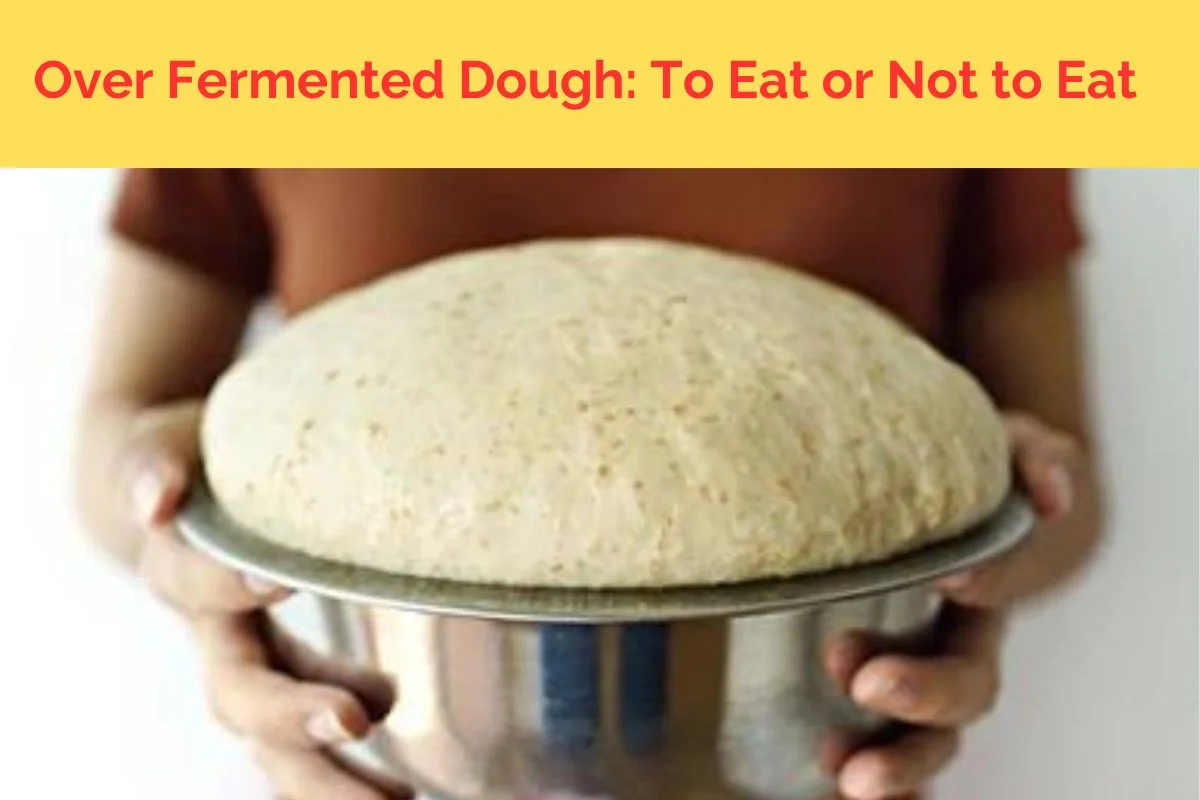
Dough fermentation is a crucial step in the baking process that enhances the flavor, texture, and digestibility of baked goods. However, like any culinary technique, there’s a fine line between achieving perfectly fermented dough and letting it go too far.
In this article, we will explore the topic of over fermented dough and whether it is safe to eat.
Table of Contents
ToggleWhat Happens if Dough is Over Fermented?
When dough is over-fermented, several undesirable changes occur. Firstly, the dough’s texture becomes excessively sticky, slack, and difficult to work with. It loses its elasticity, making shaping and handling challenging. Secondly, the taste profile shifts towards excessive sourness or bitterness due to heightened levels of lactic and acetic acids.
This can overwhelm the desired flavors in your baked goods. Furthermore, the dough may not rise adequately during baking, leading to denser and less airy final products.
Overall, over-fermentation negatively impacts the dough’s texture, taste, and baking performance, making it essential to monitor and control fermentation times for optimal results in your recipes.

What Happens If You Ferment Dough Too Long
Fermentation is a critical step in the bread-making process, but allowing dough to ferment for too long can have several undesirable consequences:
- Sour Taste: Extended fermentation causes an overproduction of lactic acid and acetic acid, resulting in a sour taste. While desirable in sourdough bread, excessive sourness can overwhelm other flavors.
- Dough Collapse: Over-fermented dough loses its structure and becomes sticky and slack. It may collapse or spread out excessively, making it challenging to shape.
- Texture Changes: The dough’s texture can become less appealing, with a gummy or overly elastic consistency. This can lead to a less-than-ideal mouthfeel in your baked goods.
- Reduced Rise: Over-fermented dough may not rise well during baking, resulting in a denser and less airy final product.
- Flavor Imbalance: The intense fermentation can overpower the dough’s natural flavors and create an unbalanced taste.
Can Over-Fermented Dough Be Saved?
While it’s challenging to fully reverse the effects of over-fermentation, there are some strategies you can try to salvage your dough and still create usable baked goods:
- Blend with Fresh Dough: One method is to mix the over-fermented dough with an equal amount of freshly prepared dough. This balances out the flavors and fermentation levels, allowing you to proceed with your recipe.
- Shorten Rising Time: After blending, allow the dough to rise for a shorter time than usual. This can help reduce the excess fermentation and improve the dough’s texture and flavor.
- Adjust Recipe: Modify your recipe to accommodate the unique qualities of over-fermented dough. Consider using it for bread varieties that benefit from a tangy or sour flavor profile, such as artisan or sourdough bread.
- Make Flatbreads: Over-fermented dough can work well for flatbreads like naan or focaccia, where its intense flavor can be a bonus.
While it may not be possible to completely restore over-fermented dough to its original state, these techniques can help salvage it for various culinary purposes. Experimentation and creativity can often lead to delicious results, even with dough that has undergone excessive fermentation.
Is it OK to Eat Fermented Dough?
Yes, it is generally safe to eat fermented dough, provided that it has not been contaminated with harmful bacteria or spoiled ingredients during the fermentation process. Fermentation is a natural culinary technique used to enhance the flavor, texture, and digestibility of dough-based products like bread and pizza.
However, when we talk about eating fermented dough, we typically refer to dough that has not over-fermented. Over-fermentation can result in a dough that is overly sour, bitter, or unpalatable. In such cases, the quality and taste of your baked goods may be compromised.
It’s essential to differentiate between well-fermented dough and dough that has gone too far in the fermentation process. Properly fermented dough often yields delicious, light, and flavorful bread. On the other hand, over-fermented dough may lead to less desirable outcomes.

What Does Over-Fermented Dough Look Like?
Over-fermented dough exhibits distinct visual and sensory cues:
- Size Increase: Initially, the dough rises but eventually collapses, losing its structure.
- Texture: It becomes overly soft, sticky, and less elastic, making it challenging to work with.
- Color: The dough may darken or take on a grayish tint.
- Odor: It develops a sour, sometimes unpleasant, smell due to increased yeast activity.
- Taste: The flavor intensifies, becoming tangy or bitter, which may not be desirable for most recipes.
Recognizing these signs allows you to salvage or repurpose over-fermented dough, ensuring your baked goods maintain quality and taste.
What to Do with Over Fermented Dough
If you find yourself with over-fermented dough, don’t despair. While it may not be suitable for all types of baked goods, there are still ways to salvage it and put it to good use:
- 1. Incorporate It into Sourdough Recipes: Over-fermented dough can actually enhance the flavor of sourdough bread. Use it as a starter for your next sourdough batch. Mix it with fresh dough to balance out the fermentation and create a tangy loaf.
- 2. Make Flatbreads: Over-fermented dough can be ideal for flatbreads like naan or focaccia. The intense flavors resulting from over fermentation can complement these bread types wonderfully.
- 3. Create Savory Pancakes: Turn your over-fermented dough into savory pancakes or crepes. The unique taste can add an interesting twist to your breakfast or brunch.
- 4. Use it in Pizza Dough: The strong flavors of over-fermented dough can make for a unique and tasty pizza crust. Simply mix it with fresh dough to mellow out the taste.
- 5. Experiment with Flavors: Over-fermented dough can serve as an excellent base for experimenting with different flavors. Add herbs, spices, or cheese to create unique bread variations.
- 6. Feed It to Compost: If you’re not in the mood to salvage the dough, consider using it as compost material. It will decompose naturally and contribute to your garden’s nutrient-rich soil.
7 Ways to Prevent Over-Fermented Dough
Preventing over-fermented dough is essential to ensure your baked goods turn out perfectly. Here are some key steps to help you maintain control over the fermentation process:
- 1. Accurate Recipe and Timing: Start with a reliable recipe that specifies the exact amount of yeast or sourdough starter and the recommended fermentation time. Following these guidelines will help you avoid over fermentation.
- 2. Monitor the Dough: Keep a close eye on your dough during the fermentation process. Check its size and texture regularly. When it has doubled in size and has a slightly airy, elastic texture, it’s often ready for the next step in your recipe.
- 3. Control Temperature: Temperature plays a significant role in fermentation. Warmer temperatures accelerate the process, while cooler temperatures slow it down. Use a thermometer to ensure your dough is fermenting at the recommended temperature, typically between 70°F to 75°F (21°C to 24°C).
- 4. Use Fresh Ingredients: Ensure that your ingredients, especially yeast or sourdough starter, are fresh and active. Old or expired yeast may lead to inconsistent fermentation.
- 5. Adjust for Humidity: High humidity can speed up fermentation, so consider this when fermenting your dough. If it’s a particularly humid day, you might want to reduce the fermentation time slightly.
- 6. Experiment and Learn: Dough fermentation can vary depending on many factors, including flour type, altitude, and even the quality of your water. Don’t be afraid to experiment and learn from your results to fine-tune your process.
- 7. Refrigeration: If you need to slow down fermentation, you can place your dough in the refrigerator. Cold temperatures significantly retard the process, allowing you more control over when to proceed with baking.
By following these steps and paying attention to the signs of fermentation, you can consistently create perfectly fermented dough that results in delicious and well-textured baked goods. Remember, practice makes perfect, and over time, you’ll become adept at preventing over-fermentation in your dough
Conclusion
In conclusion, understanding the art of dough fermentation is crucial for achieving delectable baked goods. While it’s generally safe to consume properly fermented dough, it’s equally important to recognize the signs of over-fermentation. Overly fermented dough can lead to changes in taste, texture, and overall quality, potentially compromising the outcome of your culinary creations.
To avoid these pitfalls, remember to follow precise recipes, monitor your dough’s progress, and control factors like temperature and ingredient freshness. When over-fermentation occurs, consider creative ways to salvage it, such as blending with fresh dough or experimenting with unique recipes.
By mastering the delicate balance of fermentation, you can consistently produce mouthwatering bread and pastries that delight your taste buds and those of anyone fortunate enough to enjoy your homemade treats. Happy baking!
Lindsey Mackenzie
About me
Hi there! I’m Lindsey Mackenzie, the founder of Bake Smartly. Baking has been my passion since childhood, growing up in my father’s bakery. With Bake Smartly, I’m excited to share my love for all things sweet and savory. Join me on this delicious journey as we whip up scrumptious treats and sprinkle joy into every bite!






